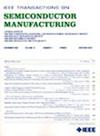Physics-Informed Machine Learning-Based Edge Detection for SEM Images
IF 2.3
3区 工程技术
Q2 ENGINEERING, ELECTRICAL & ELECTRONIC
引用次数: 0
Abstract
The Scanning Electron Microscope (SEM) images of Random Access Memory (RAM) chips contain valuable process-related information, particularly at the edges, which can provide critical insights for hotspot detection and Line Edge Roughness (LER) measurement. However, significant noise and low grayscale variation in SEM images often lead to edge omissions and misdetections. In this paper, we introduce the concept of the SEM Interlayer Effect (SIE), based on empirical observations and theoretical analysis, to address these challenges. Leveraging insights from SIE, we propose a novel Physics-Informed Edge Detection (PIED) method, which enhances the underlying neural network architecture and incorporates a hierarchical weighted loss function. Based on the real-world SEM image dataset from RAM production, PIED achieves a superior Optimal Dataset Scale (ODS) F-measure compared to the Canny edge detector, improving from 0.9001 to 0.9701—a 7.8% increase. This demonstrates that even in the absence of ground truth, PIED significantly enhances edge detection performance, which is crucial for improving process control in semiconductor manufacturing.基于物理的机器学习的扫描电镜图像边缘检测
随机存取存储器(RAM)芯片的扫描电子显微镜(SEM)图像包含有价值的过程相关信息,特别是在边缘,这可以为热点检测和线边缘粗糙度(LER)测量提供关键的见解。然而,在扫描电镜图像中,明显的噪声和低灰度变化往往导致边缘遗漏和误检。在本文中,我们在实证观察和理论分析的基础上引入了SEM层间效应(SIE)的概念,以解决这些挑战。利用SIE的见解,我们提出了一种新的物理知情边缘检测(PIED)方法,该方法增强了底层神经网络架构并结合了分层加权损失函数。基于RAM生产的真实SEM图像数据集,与Canny边缘检测器相比,PIED实现了更优的最优数据集尺度(ODS) F-measure,从0.9001提高到0.9701,提高了7.8%。这表明,即使在没有接地真值的情况下,PIED也显著提高了边缘检测性能,这对于改善半导体制造中的过程控制至关重要。
本文章由计算机程序翻译,如有差异,请以英文原文为准。
求助全文
约1分钟内获得全文
求助全文
来源期刊

IEEE Transactions on Semiconductor Manufacturing
工程技术-工程:电子与电气
CiteScore
5.20
自引率
11.10%
发文量
101
审稿时长
3.3 months
期刊介绍:
The IEEE Transactions on Semiconductor Manufacturing addresses the challenging problems of manufacturing complex microelectronic components, especially very large scale integrated circuits (VLSI). Manufacturing these products requires precision micropatterning, precise control of materials properties, ultraclean work environments, and complex interactions of chemical, physical, electrical and mechanical processes.
 求助内容:
求助内容: 应助结果提醒方式:
应助结果提醒方式:


